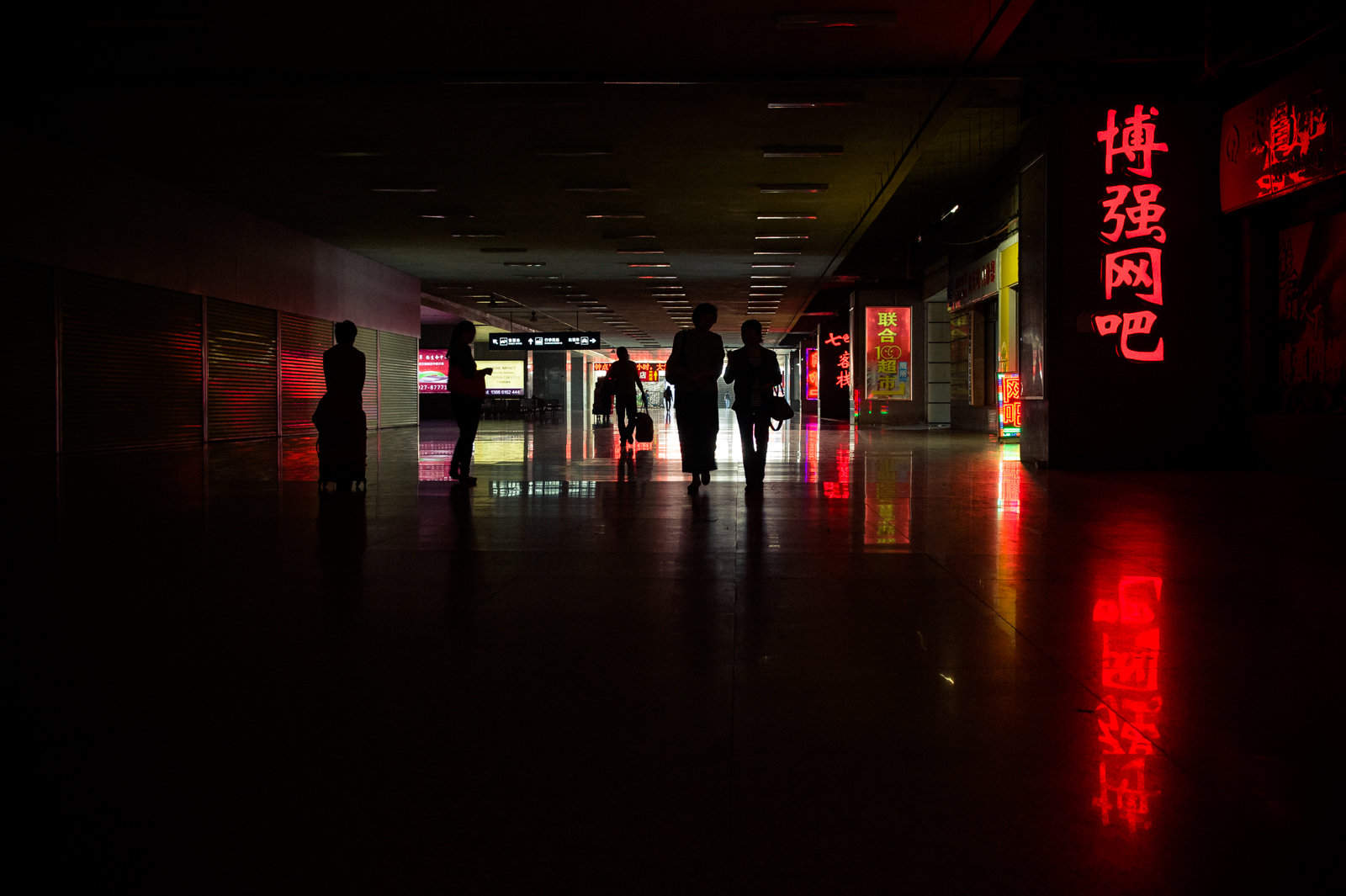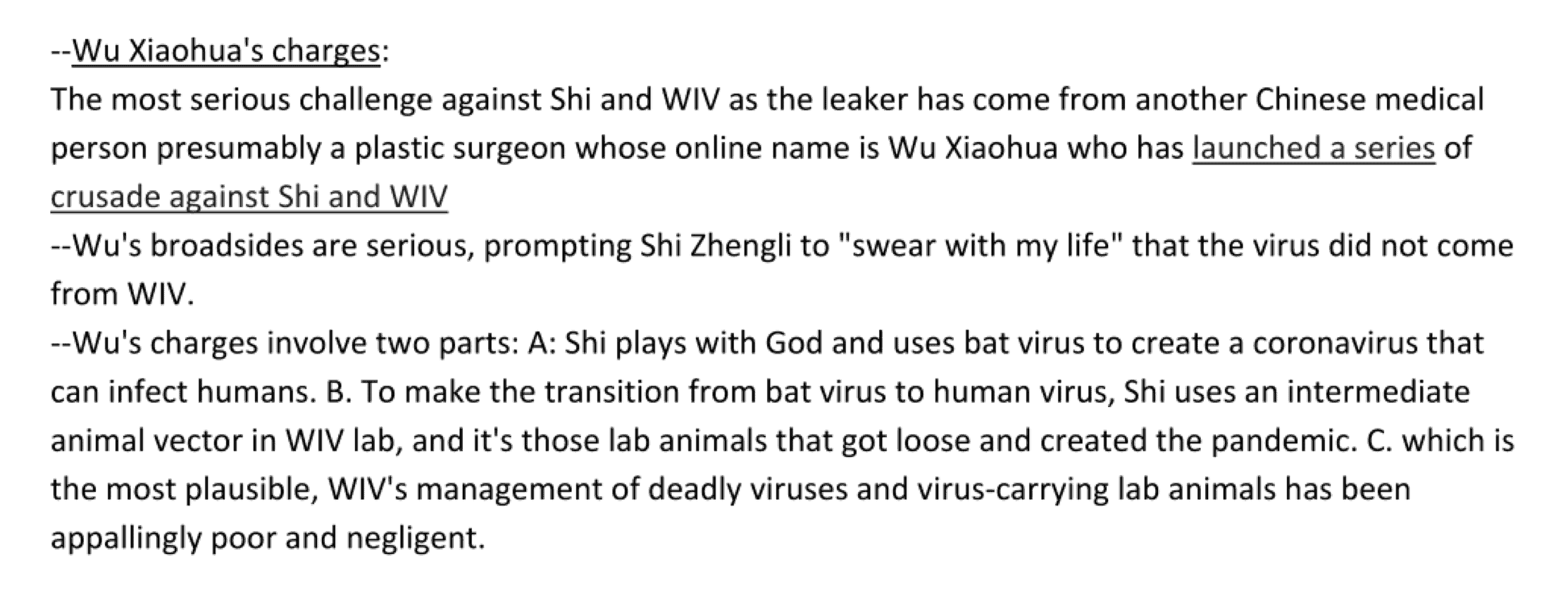
State Department officials considered a lab accident to be the most likely cause of COVID-19 in the pandemic’s early months and worried that international virologists may help with a coverup, according to a 2020 memo obtained by U.S. Right to Know.
“Origin of the outbreak: The Wuhan labs remained the most likely but least probed,” reads the topline.
The memo is written as a BLUF – “bottom line up front” – a style of communication used in the military. The identity of the author or authors is unknown.
In response to questions from a reporter, a State Department spokesperson referred U.S. Right to Know to an inconclusive 90-day review by the intelligence community in 2021.
“BLUF: There is no direct, smoking gun evidence to prove that a leak from Wuhan labs caused the pandemic, but there is circumstantial evidence to suggest such is the case,” the memo reads.
Apparently drafted in spring 2020, the memo details circumstantial evidence for the “lab leak” theory — the idea that COVID-19 originated at one of the labs in Wuhan, China, the pandemic’s epicenter.
The memo raises concerns about the “massive amount” of research on novel coronaviruses apparently conducted at the Wuhan Institute of Virology and the nearby Wuhan Center for Disease Control lab.
“The central issue involves the WCDC and WIV’s obsession with collecting and testing a massive amount of virus-carrying bats,” the memo reads.

A progenitor of SARS-CoV-2, the virus that causes COVID-19, is believed to have circulated in bats.
The memo also flags biosafety lapses at both labs, calling the Wuhan Institute of Virology’s “management of deadly viruses and virus-carrying lab animals … appallingly poor and negligent.”
The memo provides an extraordinary window into behind-the-scenes concerns about a lab accident among U.S. foreign policy leaders, even as this line of inquiry was deemed a conspiracy theory by international virologists, some of whom had undisclosed conflicts of interest.
The memo also calls into question these virologists’ impartiality.
Shi Zhengli, a Wuhan Institute of Virology coronavirus researcher nicknamed the “Bat Woman,” has forged wide-reaching international collaborations, including with prestigious Western virologists, the memo notes.
“Suspicion lingers that Shi holds an important and powerful position in the field in China and has extensive cooperation with many [international] virologists who might be doing her a favor,” it reads.

Though perhaps unknown to State Department officials at the time, one of the most influential scientists “debunking” the lab leak theory in the media, EcoHealth Alliance President Peter Daszak, had undisclosed ties to the Wuhan Institute of Virology.
China’s clampdown
The memo laments that “the most logical place to investigate the virus origin has been completely sealed off from inquiry by the [Chinese Communist Party].”
“A gag order to both places was issued on [January 1, 2020], and a Major General from the [People’s Liberation Army] took over the WIV since early January,” it states.
China has strictly controlled information about the pandemic’s origins, including barring access to the mine shaft where one of the viruses most closely related to SARS-CoV-2 was discovered, and pressuring the investigators preparing a 2021 World Health Organization report.
The memo even suggests that other hypotheses may have served as a distraction from a probe of the city’s extensive research on novel coronaviruses.
“All other theories are likely to be a decoy to prevent an inquiry [into] the WCDC and WIV,” it states.
While certain portions of the memo were previously reported in the Washington Times, many details, including the depth of concern about a coverup, were not previously known. The memo has never been published in full.
The circumstantial evidence
The circumstantial evidence presented in the memo seems to draw from public sources.
Some of that evidence has been shored up over the last two years.
For example, it makes note of so-called “gain-of-function” research Shi collaborated on that made coronaviruses more virulent and transmissible in the lab.
“[The Wuhan Institute of Virology]’s lead coronavirus scientist Shi Zhengli conducted genetic engineering of bat virus to make it easily transmissible to humans,” the memo states.
That has since been verified by media reports, in peer reviewed papers and U.S. federal grant reports.
The memo cites a 2015 paper coauthored by Shi titled “A SARS-like cluster of circulating bat coronaviruses shows potential for human emergence” that described creating a “chimera,” or engineered virus, with the spike protein of a coronavirus from a Chinese horseshoe bat.
Editors at Nature Medicine added a note in March 2020 cautioning that the article was “being used as the basis for unverified theories that the novel coronavirus causing COVID-19 was engineered.”
“There is no evidence that this is true; scientists believe that an animal is the most likely source of the coronavirus,” the disclaimer still reads.
But the memo shows that the State Department indeed considered the paper relevant to the pandemic’s origins.
The memo also describes lapses in safety monitoring at the Wuhan Institute of Virology and Wuhan’s Chinese CDC lab. U.S. Embassy cables describing poor safety monitoring at the Wuhan Institute of Virology have also been reported by the Washington Post.
And it has also been verified that some hypotheses were indeed meant to serve as a decoy, according to another State Department cable released by U.S. Right to Know last year.
A Nov. 2020 cable stated that the hypothesis that SARS-CoV-2 could be related to imported seafood products was meant to “deflect PRC responsibility.”
Other bits of information cited in the memo have not been verified.
The memo describes online posts by a Chinese national with the username Wu Xiaohua who accused Wuhan’s scientists of “playing God,” making coronaviruses more dangerous through animal vectors in the lab, and not properly cremating virus-carrying lab animals. Wu even claimed that laboratory animals were sold as pets, and that laboratory eggs were eaten by lab staff.
“Wu’s charges … are specific and have not been convincingly rebutted by WIV,” the memo states.

The memo also raises concerns about Huang Yanlin, a former employee of the Wuhan Institute of Virology whose profile was scrubbed from its website, “fueling speculation of foul play,” it notes.
“WIV has failed to convince the world of the whereabouts of its former employee Huang Yanlin, rumored to be Patient Zero,” it reads. “Huang herself has never appeared in public and has since ‘disappeared.’”
Further evidence of a clampdown at the Wuhan Institute of Virology surfaced in a State Department cable first reported by U.S. Right to Know last year. The cable stated that lab workers were instructed not to talk about COVID-19 in January 2020, according to a Guangzhou-based blogger’s social media post, before it was censored.
The memo also cites a controversial study by Indian researchers drawing a comparison between the SARS-CoV-2 genome and HIV that was withdrawn from a preprint server after other researchers said it had serious flaws.
Chinese CDC
The memo also describes circumstantial evidence suggesting the possibility of an accident at the Chinese Center for Disease Control and Prevention lab located near the Huanan Wholesale Seafood Market where most early COVID-19 cases are believed to have been clustered.
The lab houses as many as 10,000 virus-carrying bats, it alleges, citing Chinese state media.
The lab is a BSL-2 lab, lower than the BSL-4 lab required for the highest risk pathogens.
“The WCDC is a Level 2 virus safety facility which is low. The vast amount of experimental bats poses [a] serious safety issue,” it states.
The lab’s interest in viruses that circulate in bats is corroborated by a Chinese documentary in which leading virologist Tian Junhua tells filmmakers that bat caves “became our main battlefield.”
The memo alleges Tian once described being “rained on” by bat excrement and quarantining for 14 days, and notes that 14 days is the same quarantine period first recommended for COVID-19 exposure.
U.S. Right to Know obtained the memo on March 24 through a Freedom of Information Act lawsuit against the State Department as part of an investigation into possible links between risky viral research and the COVID-19 pandemic.
All of the documents about the origins of COVID-19 that USRTK has obtained by public records requests are available here while the full tranche of State Department documents can be found here.
Written by Emily Kopp









